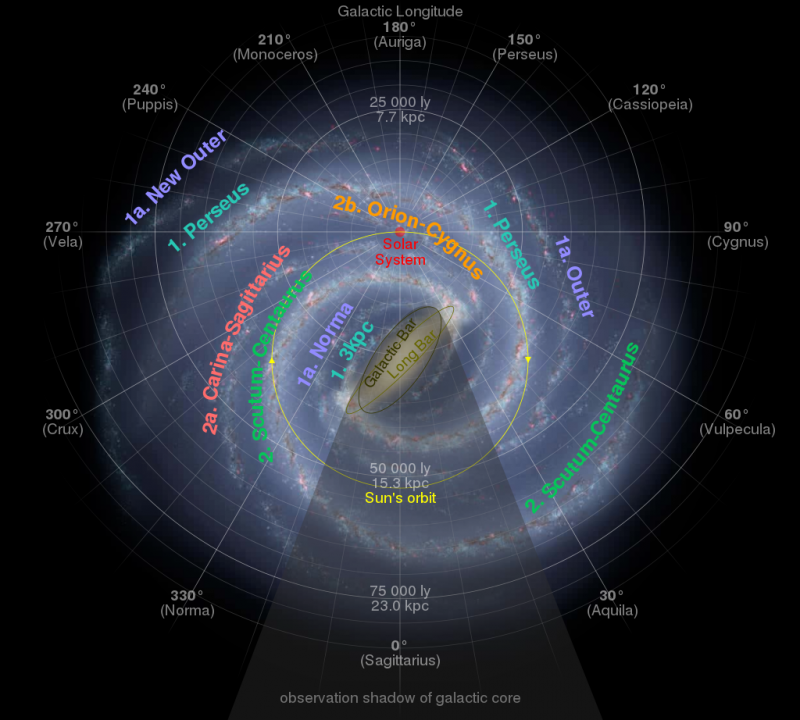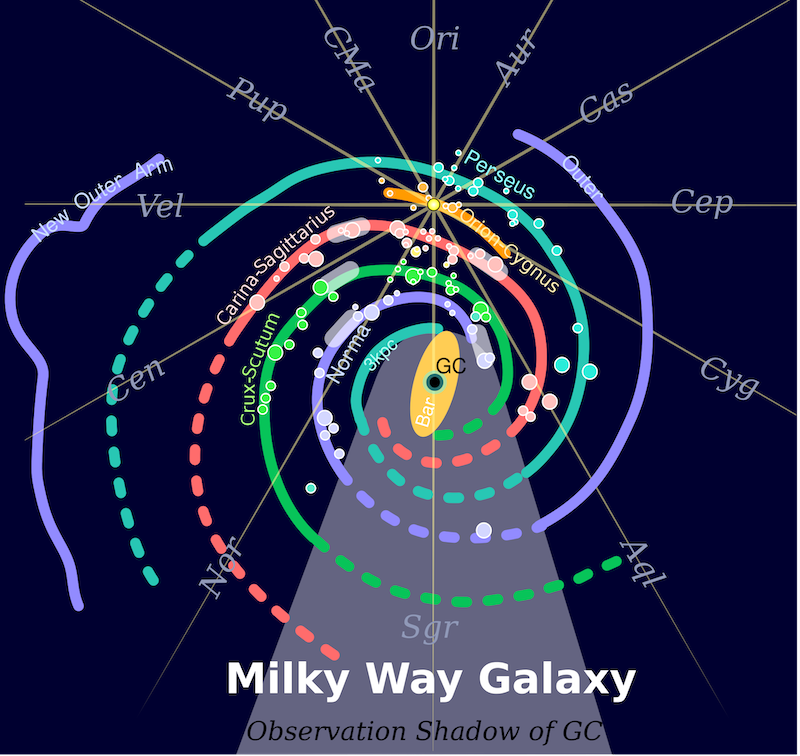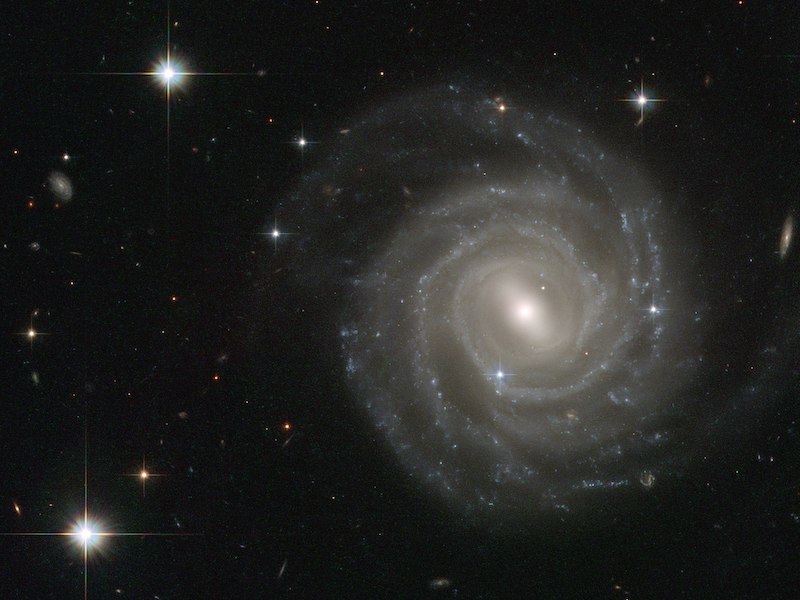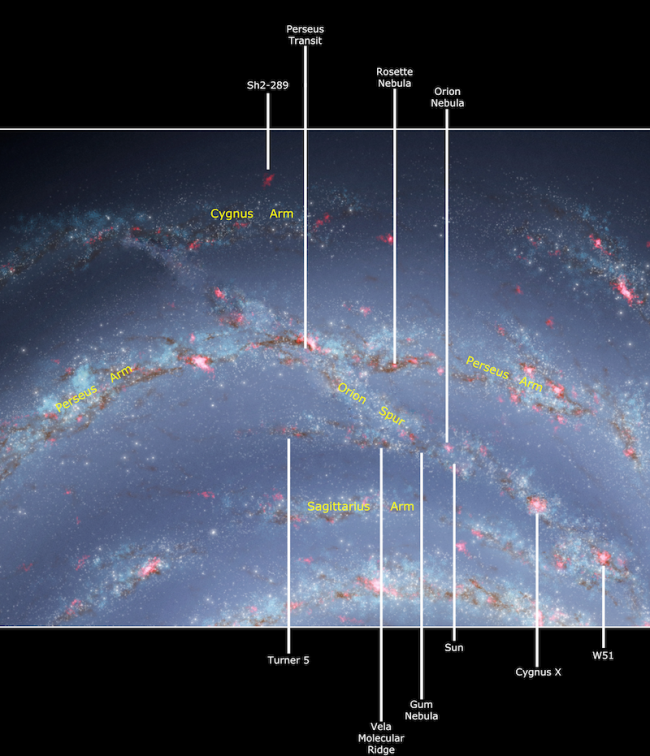
Which spiral arm of the Milky Way is home to the sun and Earth?
Our Milky Way galaxy is the island of stars we call home. If you imagine it as a disk with spiral arms emanating from the center, our sun is approximately halfway from the center to the visible edge. Our solar system lies between two prominent spiral arms, in what astronomers once thought was a mere bridge of stars, gas, and dust clouds. In recent decades, research advances have revealed that we live in our very own spiral arm of the galaxy, albeit a relatively minor one. Our spiral arm is the Orion-Cygnus Arm, or simply, the Orion Arm or Local Arm. You sometimes still hear the names Orion Bridge or Orion Spur.
The structure of the Milky Way
Th Milky Way is a barred spiral galaxy, which means it has a central bar. There’s still a lot we don’t know about the structure of our galaxy. According to the best current knowledge, the Milky Way is about 100,000 light-years across, about 2,000 light-years deep, and has 100 to 400 billion stars. There may be four primary spiral arms emanating from its center bar with an unknown number of smaller offshoot arms.
Where, within this vast spiral structure, do our sun and its planets reside? We’re about 26,000 light-years from the center of the galaxy, on the inner edge of the Orion-Cygnus Arm.
It’s sandwiched by two primary spiral arms, the Sagittarius and Perseus Arms. The artists’ concepts above and below show the various spiral arms, along with the location of our sun on the Orion-Cygnus Arm.

The Orion Arm
The Orion Arm of the Milky Way is probably some 3,500 light-years wide. Initially, astronomers thought it was about 10,000 light-years in length. A new study – published in 2016 – suggests it’s more than 20,000 light-years long.
Astronomers continue to piece together the structure of the Milky Way by painstakingly measuring the positions and distances to many stars and gas clouds. Telescopes on the ground and in space determine distances from parallax measurements. One currently operational space telescope, Gaia, is providing a wealth of new information that will allow astronomers to better characterize the Milky Way’s structure and size. In fact, Gaia’s stated goal is to provide a 3-dimensional map of our Milky Way.

How our local spiral arm got its name
The Orion Arm gets its name from the constellation Orion the Hunter, which is one of the most prominent constellations of Northern Hemisphere winter (Southern Hemisphere summer). Some of the brightest stars and most famous celestial objects of this constellation (Betelgeuse, Rigel, the stars of Orion’s Belt, the Orion Nebula) are neighbors of sorts to our sun, located within the Orion Arm. That’s why we see so many bright objects within the constellation Orion: When we look at it, we’re looking into our own local spiral arm.

Bottom line: The sun is about half the distance from the center of the Milky Way galaxy to its outer edges. It’s located in a smaller spiral arm – the Orion Arm – between two large arms.
Source: The local spiral structure of the Milky Way
The post Which spiral arm of the Milky Way holds our sun? first appeared on EarthSky.
from EarthSky https://ift.tt/3I80uNQ

Which spiral arm of the Milky Way is home to the sun and Earth?
Our Milky Way galaxy is the island of stars we call home. If you imagine it as a disk with spiral arms emanating from the center, our sun is approximately halfway from the center to the visible edge. Our solar system lies between two prominent spiral arms, in what astronomers once thought was a mere bridge of stars, gas, and dust clouds. In recent decades, research advances have revealed that we live in our very own spiral arm of the galaxy, albeit a relatively minor one. Our spiral arm is the Orion-Cygnus Arm, or simply, the Orion Arm or Local Arm. You sometimes still hear the names Orion Bridge or Orion Spur.
The structure of the Milky Way
Th Milky Way is a barred spiral galaxy, which means it has a central bar. There’s still a lot we don’t know about the structure of our galaxy. According to the best current knowledge, the Milky Way is about 100,000 light-years across, about 2,000 light-years deep, and has 100 to 400 billion stars. There may be four primary spiral arms emanating from its center bar with an unknown number of smaller offshoot arms.
Where, within this vast spiral structure, do our sun and its planets reside? We’re about 26,000 light-years from the center of the galaxy, on the inner edge of the Orion-Cygnus Arm.
It’s sandwiched by two primary spiral arms, the Sagittarius and Perseus Arms. The artists’ concepts above and below show the various spiral arms, along with the location of our sun on the Orion-Cygnus Arm.

The Orion Arm
The Orion Arm of the Milky Way is probably some 3,500 light-years wide. Initially, astronomers thought it was about 10,000 light-years in length. A new study – published in 2016 – suggests it’s more than 20,000 light-years long.
Astronomers continue to piece together the structure of the Milky Way by painstakingly measuring the positions and distances to many stars and gas clouds. Telescopes on the ground and in space determine distances from parallax measurements. One currently operational space telescope, Gaia, is providing a wealth of new information that will allow astronomers to better characterize the Milky Way’s structure and size. In fact, Gaia’s stated goal is to provide a 3-dimensional map of our Milky Way.

How our local spiral arm got its name
The Orion Arm gets its name from the constellation Orion the Hunter, which is one of the most prominent constellations of Northern Hemisphere winter (Southern Hemisphere summer). Some of the brightest stars and most famous celestial objects of this constellation (Betelgeuse, Rigel, the stars of Orion’s Belt, the Orion Nebula) are neighbors of sorts to our sun, located within the Orion Arm. That’s why we see so many bright objects within the constellation Orion: When we look at it, we’re looking into our own local spiral arm.

Bottom line: The sun is about half the distance from the center of the Milky Way galaxy to its outer edges. It’s located in a smaller spiral arm – the Orion Arm – between two large arms.
Source: The local spiral structure of the Milky Way
The post Which spiral arm of the Milky Way holds our sun? first appeared on EarthSky.
from EarthSky https://ift.tt/3I80uNQ

Aucun commentaire:
Enregistrer un commentaire